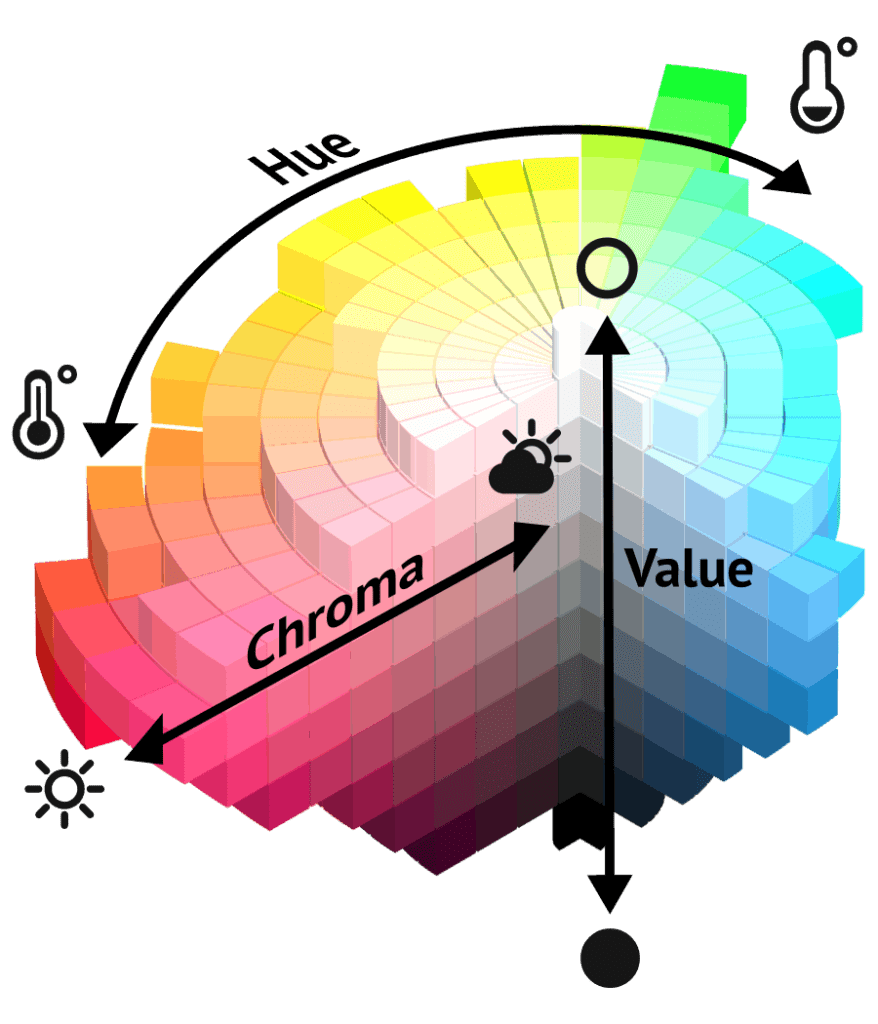Munsell Color System

The Munsell Color System, developed by Albert H. Munsell in the early 20th century, is a widely recognized and influential color system that attempts to establish universal color standards. It systematically describes and organizes colors based on three key attributes: hue, value, and chroma. This system is often used in various fields, such as art, design, geology, and color science, to communicate and specify colors consistently.
1. Hue: Hue refers to the property of a color that distinguishes it as red, yellow, green, blue, etc. In the Munsell system, hues are arranged in a circular format, creating a perceptually uniform distribution of colors around the color wheel. It makes comparing and categorizing colors easier based on their underlying hue.
2. Value: Value refers to the lightness or darkness of a color. In the Munsell system, values are arranged vertically, with the lightest colors at the top (e.g., white) and the darkest at the bottom (e.g., black). This allows for a clear and consistent way to describe how light or dark a color is.
3. Chroma: Chroma represents the intensity or saturation of a color. It describes how vibrant or dull a color appears. Higher chroma values indicate more vivid and saturated colors, while lower values indicate less saturation. The Munsell system provides a radial scale for chroma, allowing for precise differentiation of color intensity.
Hue, value, and chroma
Using these three attributes (hue, value, and chroma), the Munsell Color System creates a three-dimensional color space where any color can be uniquely identified and communicated. This systematic approach helps ensure that colors are described and reproduced consistently, making it valuable for various applications, including art, design, manufacturing, and scientific research.
Munsell’s work laid the foundation for developing other color standards and systems, and it continues to be influential in color science and design. While it’s not the only color standard in use today, it remains a valuable tool for achieving color consistency and communication in various industries.
The Munsell Color System has been widely adopted for several reasons:

The Munsell Color System’s scientific foundation, perceptual uniformity, versatility, historical significance, standardization, educational use, adaptability to technology, and interdisciplinary applications have collectively contributed to its wide acceptance and adoption in various industries and fields where color is essential.
1. Scientific Basis:
Albert Munsell’s system was one of the first to be based on rigorous scientific principles. His approach involved systematic measurements of color attributes (hue, value, and chroma) using consistent and quantifiable methods. This scientific foundation gave the system credibility and reliability.
2. Perceptual Uniformity:
Munsell’s color space is designed to be perceptually uniform. This means that equal steps in Munsell notation correspond to similar perceptual differences in color. This feature makes it easier for humans to perceive and consistently work with paints, unlike other color systems that may not have this property.
3. Versatility:
The Munsell system is versatile and can be used in various fields, including art, design, geology, and color science. Its three-dimensional representation of color (hue, value, and chroma) allows for precise color specification and communication across different industries.
4. Historical Significance:
The Munsell Color System has a long history, dating back to its development in the early 20th century. Over the years, it has gained widespread recognition and acceptance in academia, industry, and the arts. This historical significance has contributed to its continued use.
5. Standardization:
The Munsell system offers a standardized way to describe and communicate colors. This standardization is crucial in industries where color accuracy and consistency are essential, such as manufacturing, printing, and product design.
6. Education and Training:
The Munsell system is often taught in art and design schools, making it familiar to many artists, designers, and professionals in related fields. This educational component has contributed to its widespread use.
7. Compatibility with Technology:
While Munsell’s system was developed long before modern digital technology, it has been adapted and integrated into digital color management systems and software. This adaptability to new technology has helped it remain relevant in today’s color-critical industries.
8. Interdisciplinary Applications:
The Munsell system’s ability to bridge multiple disciplines, from art and design to geology and environmental science, has contributed to its widespread adoption. It allows professionals in different fields to communicate about and work with color effectively.






